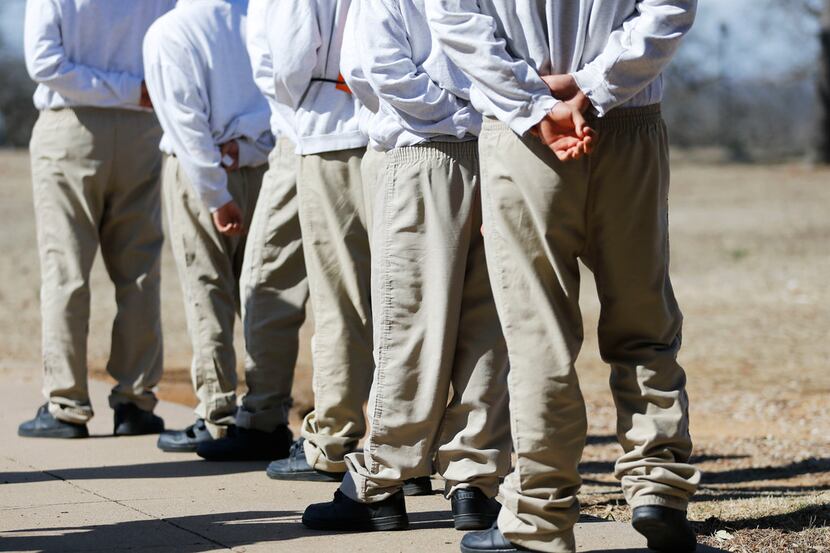Updated July 17, 2018 at 1:50 p.m. –This story has been updated to correct data comparing 2016, 2017 and 2018 numbers of referrals.
AUSTIN — The number of Texas students who have been arrested on charges of making terroristic threats and firearms violations soared after school shootings in Florida and Texas, according to a study released Tuesday by four social advocacy groups.
The study also found that black students are disproportionately referred to law enforcement compared with other racial and ethnic groups.
Release of the report, "Collateral Consequences," comes one day before a Texas Senate hearing on school violence and security.
In 2016, there were no referrals for threatening to exhibit a firearm. In 2017 there were five, and through May of this year there have been 170 referrals. This year, from January through May, there were at least 1,400 total referrals for the offenses of threatening to exhibit a firearm and terroristic threat, the study found.
As a remedy, the report suggests Texas schools take a research-based approach to assessing safety concerns rather than furthering a so-called school-to-prison pipeline and zero-tolerance system.
The report was authored by Texas Appleseed, Disability Rights Texas, Children's Defense Fund-Texas and The Earl Carl Institute for Legal and Social Policy Inc. and based on data Texas Appleseed obtained from the Texas Juvenile Justice Department for referral for terroristic threats or exhibition, use or threat of exhibition or use of firearms for 2016, 2017 and January through May of 2018.
“Students are being unnecessarily arrested and funneled into the juvenile justice system, causing lifelong damages to young people, while schools fail to distinguish between actual safety threats and ordinary child behavior,” the report says.
Among the findings:
Students age 13 to 14 had the most referrals for both offenses.
Black students represent 24 percent of referrals for terroristic threat and 31 percent of referrals for exhibition of firearms, but make up 13 percent of the student population.
Houston ISD had the largest number of referrals of any school district.
Tarrant County had the most referrals for terroristic threats of any North Texas county from January to May of this year, with 18. Harris, Nueces and Bexar counties were ahead of Tarrant.
“We must ask ourselves why black children are overrepresented in referrals given that past school shooters have often been white males,” said Morgan Owens, an Earl Carl Institute staff member.
Cases related to disabilities
The study also found a number of children with disabilities were arrested for behavior or comments that were seen by the school as threatening but could have been directly related to their disability. Some students were charged with felony offenses.
“We have seen an influx in cases where students with disabilities are being referred to law enforcement more frequently for things that are clearly connected to their disability,” said Shiloh Carter, an attorney for Disability Rights Texas.
Carter said students with disabilities often have anger episodes or other instances that are irrational, impromptu and emotional and say things they don’t mean.
“Now we’re seeing a zero-tolerance policy and very young children who are facing felony charges,” Carter said. “There needs to be a step-by-step process and evidence-based system for addressing the seriousness of a threat and how to respond more appropriately.”
Carter said she has six clients who have been affected.
One is Lawanda Galloway, who has an 11-year-old son with autism and ADHD in the Angleton ISD near Houston. He is facing felony charges in an October 2017 incident.
Galloway said her son became upset while waiting for a school party to begin. With an overwhelming number of people in the room that day and the delay of the party, she said her son tossed a textbook onto a desk in frustration. Police were called, and he was restrained, later arrested and then spent a weekend in a juvenile detention center in isolation under suicide watch.
Galloway’s son now faces two felony charges of terroristic threat and assault on a public servant. She is working with Disability Rights Texas to try to get the charges dropped.
“He doesn’t talk about the incident now; he doesn’t understand why it happened.” Galloway said. “He’s scared to do anything wrong at school because he’s afraid to be taken away again.”
The report recommends the Texas Legislature provide funding for research-based, multi-tiered approaches to school safety, with a threat-assessment model. They also recommend Texas schools utilize free summer training offered by the Texas School Safety Center.
“We understand the concern and fear schools are operating under, and we believe schools should take every threat of violence seriously,” said Texas Appleseed executive director Deborah Fowler. “The question is: how do they go about determining whether those threats are transient or substantive?”
Fowler said the threat-assessment model would allow schools to properly assess a situation and then determine the next steps.
“Some students have felony records, Class A and B misdemeanors, and those carry significant consequences,” Fowler said. “There are evidence-based alternatives to those zero-tolerance referrals and arrests.”
Morgan Craven, the Texas Appleseed “School-to-Prison Pipeline” project director, will testify at Wednesday’s hearing.

